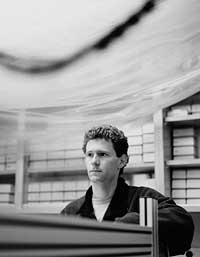Not For MDs Only
 |
|
"There was a huge potential to make a lot of money. I was totally against that." |
|
PhD alum Joe DeRisi brings innovation to the masses
Amy Adams
Photograph by Leslie Williamson
When Joe DeRisi started working toward his PhD in Pat Brown’s lab, DNA microarrays were just beginning to take off and the Brown lab was at the forefront of the field. “There was a huge potential to make a lot of money,” DeRisi says. “I was totally against that.”
Instead, DeRisi, who is now an assistant professor of biochemistry and biophysics at the University of California, San Francisco, joined Brown’s quest to bring microarrays to the masses.
“Our whole deal was to make the technology more accessible, to level the playing field.” He says the price of microarrays and the equipment to screen and analyze the results are all driven by what large companies can pay. “The people on the low end – in academics – are faced with those same prices,” DeRisi says.
The microarrays consist of glass slides covered with hundreds or thousands of DNA spots, each representing a different chunk of DNA from a given cell or tissue. Researchers can use these arrays to get a quick view of gene expression patterns. First, they isolate the mRNA “messages” from a cell or tissue and label them with a fluorescent marker. Then they expose the array to the mRNA concoction.
When the cell or tissue under scrutiny has a particularly active gene, the gene produces large quantities of mRNA. These mRNAs will bind to the corresponding DNA molecules in the microarray and will produce a brightly lit fluorescent spot. By comparing the patterns of spots between two samples, researchers can figure out which genes are differentially expressed in disease versus normal tissue, or between two organisms.
These arrays are incredibly valuable both to researchers who want a quick way to scan the expression of many genes at once and to the companies that sell them. An average array costs between $500 and $1,000. Even at this price, a researcher must make do with what genes the companies choose to print on the array. For example, some members of DeRisi’s lab study the parasite that causes malaria. “Nobody is going to print a malaria
array,” DeRisi says. Researchers who study more conventional organisms such as mice or humans are still subject to the whims of companies that choose which genes to print on their arrays.
Rather than accepting what companies offer, DeRisi advocates a do-it-yourself approach to microarray experiments through his online portal: microarray.org. DeRisi offers tips for making arrays, protocols for conducting the experiments, and free software for analyzing arrays. He even provides the blueprint for building a device that prints DNA spots onto slides, complete down to the part numbers for individual components.
For those who aren’t comfortable with online instruction, DeRisi and past Brown lab graduate student Vichy Iyer, PhD (now assistant professor at the University of Texas at Austin) offer a class at Cold Spring Harbor in New York each year to teach students how to conduct a homemade, start-to-finish DNA microarray experiment. “We specifically select people from universities that could never do this before,” DeRisi says. Past students have included researchers from Nigeria, Argentina, Chile and Ethiopia, and one U.S. high school teacher. “We want to target people who would benefit from it,” he says.
The students arrive to find parts in boxes lined up with a selection of low-tech tools. They walk away from the class having built their own microarray printer and with high-quality microarray data in hand.
DeRisi’s work is right in line with what Brown, a professor of biochemistry, has created at Stanford. While DeRisi was a graduate student, Brown’s lab would make arrays for themselves and for collaborators. When requests for their arrays became unmanageable, Brown co-sponsored the Stanford Functional Genomics Laboratory, which provides array facilities to Stanford researchers for only $95 per array – essentially at cost.
The same social conscience that drives DeRisi’s microarray work also directs his research goals. One of his lab’s primary projects involves the parasite that causes malaria. He’s hoping to develop an anti-malaria drug that’s cheap, effective and easy to transport. “The whole goal is to come up with novel therapeutics,” DeRisi says.
About 2.7 million people die from malaria each year, but DeRisi says that the disease isn’t widely studied in the United States. “That’s because research is profit driven,” DeRisi says. “The people who die from malaria don’t carry credit cards.”
Instead, malaria primarily hits Third World countries. This adds to the challenge of developing a drug, because any candidate needs to be cheap to produce and easy to store. This challenge is offset by the number of people who would benefit from an effective drug. “If you have a novel treatment for malaria, that’s just giant,” DeRisi says.
DeRisi’s lab takes a multi-pronged approach in its search for the ideal malaria drug. Some of the work revolves around finding new versions of drugs that have lost their effectiveness against the ever-evolving parasite. DeRisi also looks at parasites’ gene expression patterns when exposed to potential drugs – experiments done on arrays printed by DeRisi and his lab members.
Far from being a distraction from this primary research, he says that his work on microarray.org helps him make valuable scientific connections. “The more people you interact with, the more successful you will be in science,” he says.
Plus, DeRisi says that helping people gain access to valuable technology is the right thing to do. “I really learned that in Pat Brown’s lab,” DeRisi says. “He instilled the idea that it is important to do things that benefit other people.”
Comments? Contact Stanford Medicine at

